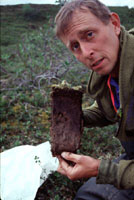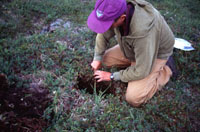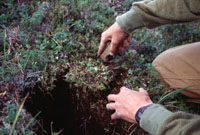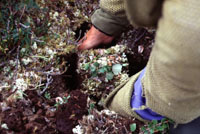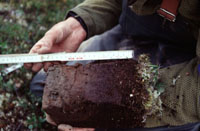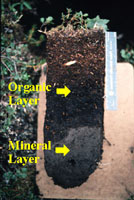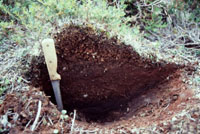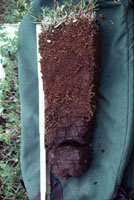|
|
|||||||||||||||||
What is soil? How does it form?Soil is a combination of four main things: minerals (from rock), organic matter (from dead and decaying organisms), water, and air. Often soil can be seen as a series of different layers from the bedrock (the deepest) to the organic layer (the top layer that you can see when you walk on it). Soil has more living organisms (bacteria, small plants and animals, fungi) per handful than anything else-- probably more than a million individual life forms in a bucketful! Soil is important to many living things, especially plants. Plants rely on soil for three main things: water, nutrients (food), and oxygen. Plants can also change the soil by growing in it. Soil is formed in a number of different ways: growing plants can add material to the soil when they die and decay, rocks and minerals can break down and mix with soil, erosion by wind or water can remove certain elements of the soil while leaving others, and particles within soil layers can move and mix. But soil differs from location to location. Several factors affect the type of soil found in a certain place, including: climate (precipitation, temperature, etc.), organisms present (plants, animals, fungi, etc.), elevation, slope, depth to the water table, the type of bedrock underneath, geologic history (were there once glaciers scouring the area? How about oceans or lakes?) In Alaska, the climate is generally cold. How does this affect the soil? The normal processes of breaking down dead plant and animal material (the organic material) happen much more slowly in Alaskan soils than in temperate areas to the south because the colder temperatures keep things from breaking down as fast. The organic layers tend to build up and accumulate into deep layers of slowly decomposing organic material. In fact, the presense of permafrost-- a year-round frozen layer of soil just below the surface-- keeps some plant and animal material from decomposing at all. This layer of cold organic material is like a library of stored information. Since we want to learn what plants grew in these places a long time ago, we can look below the surface at pieces of plant fruits, leaves, stems, and seeds that haven't decomposed yet. We can also learn if there were any recent fires by looking for charcoal pieces. Charcoal lasts for a long time in the soil, so if there are big (greater than 1 millimeter) charcoal pieces, then a fire may have burned on or near the area at some point in time, perhaps hundreds of years ago. We can determine how long ago a fire burned by using radio carbon dating (or carbon 14 dating). Click here to learn about radio carbon dating. Because the organic layer is made up of dead plant and animal material, and because plants and animals (and all living things) are made up of carbon (an element), the organic layer in Alaska holds lots of carbon underground. (And this may have influences on the climate-- click here to learn more.) How did we collect soil samples? Follow the pictures and listen to the audio below.
|
|||||||||||||||||
|
|||||||||||||||||
|
|||||||||||||||||
|
|
|||||||||||||||||
All Rights Reserved (R) Middlebury College Biology, 1999, 2000
